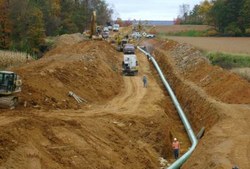
Natural gas rigs are a unique picture of shale drilling. Further, there are components that are required for getting natural gas from the consumer to the well.
Last week, the major components necessary for getting gas to the consumer were mentioned. With the need for infrastructure, how are pipelines constructed?
The engineering and planning departments of industry work to come up with the best route for connecting wells to the interstate pipeline. Company right-of-way agents will approach landowners for easements (also called right-of-way agreements).
Once landowner approval for the route is secured, it will be surveyed and the centerline of the right-of-way is determined. Environmental permitting is submitted to all necessary agencies, ensuring wetlands and stream crossings are taken into consideration.
Only when final permitting approval and regulatory processes have been received and followed will the land be cleared and graded. Trees, shrubs and boulders will be removed.
Sections of the pipe, usually 40 to 80 feet long, are laid along the path in a process called ‘stringing pipe’. Trenches are dug, as pipeline is usually buried at least 30 inches below the surface.
Pipelines are not straight, so the pipe must be bent and angled to fit the contours of the trench. The pipes are then welded, inspected and then an epoxy coating is applied over the welded sections.
It is important that the entire coating is inspected and free of defects. The pipe is lowered into the trench by specialized equipment, making sure the pipe’s integrity is not compromised.
The trench is backfilled, and a hydrostatic test is conducted. Water is sent through the pipeline at pressures higher than needed for natural gas transportation for 24 hours to ensure the integrity of the welds and the pipe itself.
Once the pipeline has been installed, the area is restored to its original state, or as agreed upon with the landowner.